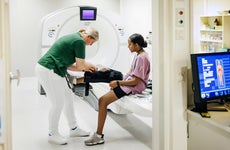Best credit cards for pharmacies and drugstores

The Bankrate promise
At Bankrate we strive to help you make smarter financial decisions. While we adhere to strict , this post may contain references to products from our partners. Here's an explanation for . The content on this page is accurate as of the posting date; however, some of the offers mentioned may have expired. Terms apply to the offers listed on this page. Any opinions, analyses, reviews or recommendations expressed in this article are those of the author’s alone, and have not been reviewed, approved or otherwise endorsed by any card issuer.
From peak flu season to a summer cold, a rewards credit card that covers pharmacy and drugstore purchases can be a valuable way to save money on prescriptions and over-the-counter medicines. In fact, Organisation for Economic Co-operation and Development (OECD) data shows that Americans spend much more out of pocket on pharmaceuticals per person than those in other countries do on average. According to the latest data, that’s $1,376.27 per year. A card that earns 3 percent cash back on pharmacy purchases therefore would put $41 back in the average American’s pocket.
A good drugstore rewards card might not land you a fortune, but these rewards could cover the copay for one or more doctor visits when you need them. But with the right credit card, you could earn even more rewards.
Below, we’ll take a look at some of the best rewards cards for drugstore and pharmacy purchases, depending on what you’re looking for:
- Best for U.S. supermarket pharmacies: Blue Cash Preferred® Card from American Express
- Best for flat-rate cash back: Chase Freedom Unlimited®
- Best for rotating category cash back: Discover it® Cash Back
- Best for choice category cash back: Bank of America® Customized Cash Rewards credit card
- Best for Amazon Pharmacy and Whole Foods vitamins: Amazon Prime Rewards Visa Signature Card
Best pharmacy and drugstore credit cards
Best for U.S. supermarket pharmacies: Blue Cash Preferred Card from American Express
Besides being one of the best grocery credit cards, the Blue Cash Preferred® Card from American Express is also one of the best cash back cards for prescriptions filled at supermarkets. You’ll earn an amazing 6 percent cash back on purchases at U.S. supermarkets (on up to $6,000 per year, then 1 percent back) for a small $95 annual fee. If you meet the spending limit, that means you could earn at least $360 on supermarket spending. Subtract the annual fee of $95 and you’d still earn $265 in rewards.
If you expect your pharmacy expenses to shoot past this spending cap, the American Express® Gold Card is a great alternative to consider. It offers an outstanding 4X Membership Rewards points on up to $25,000 in U.S. supermarket purchases per year, albeit for a heftier $250 annual fee.
Best for flat-rate cash back: Chase Freedom Unlimited
The Chase Freedom Unlimited®’s standard 1.5 percent cash back on all purchases is helpful for online prescription services and health expenses that fall outside standard bonus categories, but the card also goes above and beyond with its extra bonus categories. You’ll rake in an unlimited 3 percent cash back on drugstore and dining purchases.
However, you could potentially earn an additional 1.5 percent cash back for each category (including drugstore purchases; on up to $20,000 in purchases) during the first year if you apply for the card through Bankrate or our CardMatch tool. That means you’ll get 4.5 percent back on all drugstore purchases and at least 3 percent back on all purchases.
It’s also hard to ignore the card’s excellent perks—which you don’t normally find on a no-annual-fee card—and the potential pairing benefits with other Chase Ultimate Rewards cards.
Best for rotating category cash back: Discover it Cash Back
Drugstore shoppers that prefer rotating cash back categories won’t have to sacrifice pharmacy rewards with the Discover it® Cash Back. With this card, you can earn 5 percent cash back on rotating categories each quarter (up to $1,500 in purchases, then 1 percent; activation required) and 1 percent for all other purchases. So, each quarter, you could earn up to $75 in cash back.
According to the Discover cash back calendar, prescriptions are essentially covered throughout 2022. In the past, Walgreens and CVS were among the category bonus options, but cardholders can still receive cash back on prescriptions at grocery stores, Target, PayPal and Amazon in 2022.
You can earn 5 percent cash back on up to $1,500 in combined purchases per quarter by filling prescriptions at:
- Grocery stores from January to March 2022
- Target from April to June 2022
- PayPal (by filling your prescriptions online for delivery or pickup) from July to September 2022
- Amazon.com through October to December 2022
Best for choice category cash back: Bank of America Customized Cash Rewards credit card
If you need a bit more consistency and versatility than rotating categories allow, but you want specialized rewards, then the Bank of America® Customized Cash Rewards credit card is a flexible alternative.
You can get 3 percent cash back on category purchases of your choice (including drugstores), and you can swap them every month if desired. The ongoing 2 percent cash back category can then step in to reward prescriptions filled at grocery stores and wholesale clubs during months that you need a different 3 percent category.
Unfortunately, the 3 and 2 percent categories share a $2,500 quarterly spending limit before dropping to 1 percent cash back. This can be offset a bit if you’re a Bank of America Preferred Rewards member since you can earn an extra 25 percent to 75 percent cash back on all purchases. Still, with a rate of 3 percent back for drugstore purchases and the quarterly spending limit in mind, you could earn up to $75 back per quarter ($300 per year).
Bank of America® Customized Cash Rewards credit card information last updated on August 23, 2022.
Best for Amazon Pharmacy and Whole Foods vitamins: Amazon Prime Rewards Visa Signature Card
Avid Amazon shoppers can use the Amazon Prime Rewards Visa Signature Card to earn 5 percent cash back on Amazon and Whole Foods Market purchases. Once you consider that Amazon Pharmacy delivers prescriptions, unlimited 5 percent back is a stellar deal for a card with no annual fee (Amazon Prime membership required to apply).
Plus, for prescriptions not through Amazon, the Amazon Prime Rewards card offers 2 percent back at drugstores and 1 percent back on all other purchases.
Comparing the best pharmacy and drugstore cards
| Card name | Best for… | Rewards | Annual fee | Welcome offers |
|---|---|---|---|---|
| Blue Cash Preferred® Card from American Express | U.S. supermarket pharmacies |
|
$95 |
|
| Chase Freedom Unlimited® | Flat-rate cash back |
|
$0 |
|
| Discover it® Cash Back | Rotating category cash back |
|
$0 |
|
| Bank of America® Customized Cash Rewards credit card | Choice category cash back |
|
$0 |
|
| Amazon Prime Rewards Visa Signature Card | Amazon Pharmacy and Whole Foods vitamins |
|
$0 (Amazon Prime subscription required) |
|
How to choose a drugstore credit card
When choosing a credit card for drugstores, you’ll want to consider a few factors, including your medical needs, how often you typically shop at pharmacies and where you do most of your shopping.
- If your prescriptions are on the expensive side or you fill them at retailers that don’t typically earn rewards (like Walmart and other superstores), a flat-rate rewards card or a card with an unlimited pharmacy rewards category might be your best option.
- A retail credit card might be worth considering if you shop at a particular store, but just remember that store cards aren’t always worth it on account of their typically narrow uses and high rates and fees.
- Bonus category credit cards can provide higher reward rates than flat-rate cards, while retaining year-round flexibility, but rotating category cards may net the most rewards if your drugstore spending is seasonal.
- Although flat-rate or consistent bonus category cards might help if you have prescriptions for a chronic condition or other ongoing pharmacy costs, a rewards card might not be your best option. A zero-interest card or a credit card designed for medical expenses might be a better fit if you’re more concerned about covering your health costs than receiving rewards.
How to maximize your drugstore rewards
Earning cash back on pharmacy purchases is often as simple as using a grocery rewards card at a supermarket’s prescription counter, but there are a few other tricks to make the most of your drugstore rewards.
- Centralize your spending. Shopping at drugstores tends to be pricier than convenience stores or supermarkets, but the rewards from shifting your small purchases to drugstores can add up over time. Tip: Taking advantage of the Citi Rewards+® Card’s point roundup feature on these small items and pooling rewards with the Citi Premier® Card is an easy way to squeeze out more points per dollar.
- Pair your cards. Like the Citi Rewards+ combo, you can stretch your rewards a bit further by combining different cards’ features.
- Take advantage of drugstore loyalty programs. You can use the CVS ExtraCare and myWalgreens programs to stack extra discounts.
The bottom line
The best drugstore or pharmacy credit card for you depends on a number of factors: your medical needs, where you do most of your shopping, whether you’re open to paying an annual fee or not and whether you’d like to earn rewards in other categories. There are a number of no-annual-fee cards that offer at least 2 to 3 percent back at drugstores, but if you spend a lot on supermarket prescriptions and in certain bonus categories, a card with an annual fee could provide more cash back rewards—making the annual fee worth it.
The information about the Amazon Prime Rewards Visa Signature Card has been collected independently by Bankrate.com. The card details have not been reviewed or approved by the card issuer.
Related Articles



